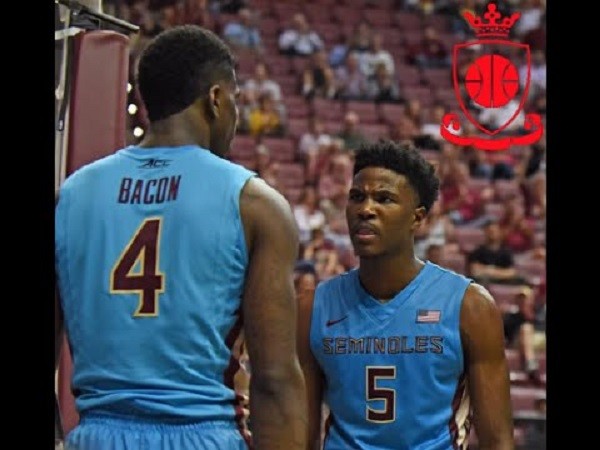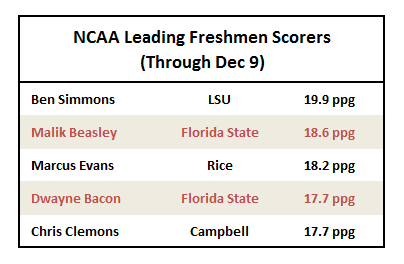Florida State Newcomers Making Huge Impact
Posted by Brad Jenkins (@bradjenk) on December 13th, 2015In the 2014-15 season, Leonard Hamilton’s Florida State squad was severely hampered by a lack of depth on the perimeter. But, what was a weakness last year is now a strength of this year’s Seminoles. Led by a pair of explosive freshmen, Dwayne Bacon and Malik Beasley, Florida State (5-2) not only is more talented this season, but it may be one of the most balanced teams of Hamilton’s 14 years at the helm in Tallahassee.

Florida State’s Dwayne Bacon and Malik Beasley are the nation’s leading freshmen scoring duo.
(youtube/Nation Hoops)
With no real quality depth last season, Florida State’s three primary perimeter players all averaged about 35 minutes per contest. Certainly that made it almost impossible for the Seminoles to play the way Hamilton usually likes his teams to play — using waves of athletes to pressure opponents. So far this year, only sophomore Xavier Rathan-Mayes is logging over 28 minutes per game and his time on the floor (30.4) is almost five minutes less than it was a season ago. Bacon and Beasley are each playing around 27.5 minutes per contest as starters and fellow frosh Terance Mann is coming off the bench for about 15 minutes of action each game. It’s fair to say that Florida State’s freshmen class has performed above expectations so far. Compared to the consensus top two rookie classes in the country (see table below), the Seminoles newcomers are outperforming Duke’s rookies and are statistically close to Kentucky’s.
 Additionally, Bacon and Beasley are currently the highest scoring freshmen duo in the country (see chart below). While both were highly regarded coming out of the high school ranks, Bacon (ESPN #14) was the one expected to make a major impact immediately. The strong 6’7″ forward was particularly impressive during the week of the 2015 McDonald’s High School All-American game – winning the slam-dunk contest along the way. In addition to his efficient scoring (52.2% FG), Bacon is leading the team in rebounding at a 5.4 per game clip. A 6’5″ guard, Beasley was slightly lower rated (ESPN #28), and wasn’t initially pegged to be a starter, since the Seminoles returned their starting backcourt intact from a year ago. But Beasley won a starting spot in preseason, and quickly showed why – scoring at least 20 points in five of the first six games of his career. He’s also been lights out from beyond the arc, converting 16-of-31 on his three-point tries.
Additionally, Bacon and Beasley are currently the highest scoring freshmen duo in the country (see chart below). While both were highly regarded coming out of the high school ranks, Bacon (ESPN #14) was the one expected to make a major impact immediately. The strong 6’7″ forward was particularly impressive during the week of the 2015 McDonald’s High School All-American game – winning the slam-dunk contest along the way. In addition to his efficient scoring (52.2% FG), Bacon is leading the team in rebounding at a 5.4 per game clip. A 6’5″ guard, Beasley was slightly lower rated (ESPN #28), and wasn’t initially pegged to be a starter, since the Seminoles returned their starting backcourt intact from a year ago. But Beasley won a starting spot in preseason, and quickly showed why – scoring at least 20 points in five of the first six games of his career. He’s also been lights out from beyond the arc, converting 16-of-31 on his three-point tries. When a team returns all five starters like Florida State does this year, but brings in talented players like Bacon and Beasley, some veterans are forced to change roles. Rathan-Mayes seems to be embracing his role as more of a distributor this year — his scoring is down from 14.9 points per game in 2014-15 to 12.6 this season, but he has increased his assists by almost two per outing. Seniors Devon Bookert and Montay Brandon are playing about 10 minutes less per game but still finding ways to contribute. Bookert has struggled with ball-handling in the past – 1.29:1 assist-to-turnover ratio for three prior years. But he has 20 assists versus only nine miscues so far this campaign. Meanwhile, the versatile Brandon has sacrificed his offense — his scoring is down about six points compared to last year — by playing more in the paint and focusing on defense.
When a team returns all five starters like Florida State does this year, but brings in talented players like Bacon and Beasley, some veterans are forced to change roles. Rathan-Mayes seems to be embracing his role as more of a distributor this year — his scoring is down from 14.9 points per game in 2014-15 to 12.6 this season, but he has increased his assists by almost two per outing. Seniors Devon Bookert and Montay Brandon are playing about 10 minutes less per game but still finding ways to contribute. Bookert has struggled with ball-handling in the past – 1.29:1 assist-to-turnover ratio for three prior years. But he has 20 assists versus only nine miscues so far this campaign. Meanwhile, the versatile Brandon has sacrificed his offense — his scoring is down about six points compared to last year — by playing more in the paint and focusing on defense.
The overall win-loss record is about as expected at this point, but Florida State is trending much better in some advanced stats this year. The Seminoles’ adjusted offensive efficiency (Kenpom #45) is the best it’s been in the last nine years, and the defense, once a given under Hamilton, is at it’s highest ranking (Kenpom #30) since 2012, which happens to be the last time Florida State played in the Big Dance. By digging even deeper, we uncover the fact that Hamilton’s club is doing much better this season in two areas that have traditionally been a struggle for them. After turning the ball over on more than 21 percent of its possessions in all previous 13 Hamilton-led years, Florida State has that number down to 18.8 percent after seven games this year. And this deep and athletic lineup is holding opponents to a mere 25.2 percent offensive rebound rate, after never doing better than 30.9 percent (2011) in the Hamilton era. It remains to be seen if the youngsters can continue such a high level of production once ACC play gets under way, but with his deepest team in years, Hamilton has to feel pretty good about having a solid chance to finish high enough in the league standings to earn a trip back to the NCAA tournament.










































